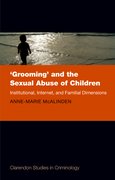By Dr Anne-Marie McAlinden
The word ‘grooming’ has become synonymous with child sexual abuse. It is often used to describe situations of extra-familial abuse, where predatory strangers befriend children who were previously unknown to them. Two of the most prominent social connotations of the term are ‘online grooming’ committed via the internet and ‘institutional grooming’ and abuse committed by those in positions of power and trust.
While ‘grooming’ is a useful short-hand to describe the staged process of befriending children in order to prepare them for abuse and prevent disclosure, it is a term that needs to be used with caution. There is a need to acknowledge the complexities of the onset of sexual offending against children and recognise that there will not always be pre-abuse grooming in every case. The unmitigated use of such terminology, however, can serve to mask these complexities. That being said, grooming of the child, significant others, or the environment is a highly significant and multi-layered variable in child sexual abuse. Unpacking and confronting some of these nuances is vital to protective and preventive efforts.

Within intra-familial contexts, there is often no need to groom prior to the first offence, since in many cases the abuser will already be physically proximate to the child. ‘Familial grooming’, however, can operate not only upon the child but also other protective adults and the environment itself. In the case of father-daughter abuse, for example, the would-be offender may groom or manipulate the mother in order to create the opportunity to be alone with the child and abuse undetected. Similarly, the immediate familial surroundings can also be groomed so that inappropriate behaviours are normalised and the victim ultimately does not recognise themselves as such.
Further complexities arise in relation to the potential cross-over between victimhood and an offending identity. This is particularly the case where abuse occurs on an organisational level. A minority of enquiries into institutional child abuse have demonstrated that victims report being abused by their peers as well as adults where abuse has become part of the organisational culture. Similarly, peer-to-peer grooming also has resonance in the context of ‘localised’ or ‘street grooming’. Recent high profile cases such as those in Rochdale and Oldham demonstrate that young girls may recruit other children and young people into exploitative situations, which in its worst form becomes organised abuse or trafficking.
Such complexities which underlie the onset of sexual offending against children also have broader significance in terms of recognising and challenging inappropriate pro-offending behaviour. It is widely assumed that the adult male is the most typical offender. Sexual offences committed by young people and females, however, together comprise a substantial proportion of official statistics on sexual offending against children (approximately one-third and 5% respectively). These groups of offenders may have different motivations and may initiate abuse in different ways to adult male offenders, whether this is more experimental or relational and less overt.
As an extension of the concept of institutional grooming, sex offenders may seek to manipulate professionals who are charged with their assessment, treatment, or management into discounting their risk to children. However in order to protect children it is vital to remember that all sex offenders act and think differently, and their routes into offending don’t fit any particular. Stereotyping predatory offenders in this way can be dangerous, by detracting our attention from other possible sources of harm to children. Similarly, whole communities can be groomed to view offenders as trustworthy individuals. The ongoing investigation concerning abuse by the late Jimmy Savile highlights potential societal grooming in evidence on a large scale. It is arguable that Savile used his influence to groom not just his victims but society as a whole, abusing his position of trust and authority which was amplified by his celebrity status.
Ultimately, at the tertiary level, the prevention of child sexual abuse in the form of legal and policy frameworks only comes into play once risk is known and identified. Some of these complexities concerning grooming point towards the need for additional social policies at the primary and secondary levels of prevention. Specifically, public health approaches aimed at raising awareness of child sexual abuse and promoting identification and intervention should be targeted at children, families, potential offenders, and wider society. This should involve a continuum of services centring on the creation of a ‘safeguarding’ culture within families, communities, and organisations.
Dr Anne-Marie McAlinden is Reader in Law at Queen’s University Belfast. Her book ‘Grooming’ and the Sexual Abuse of Children: Institutional, Internet and Familial Dimensions published in December 2012.
Subscribe to the OUPblog via email or RSS.
Subscribe to only sociology articles on the OUPblog via email or RSS.
Image credit: School children walking in corridor (motion blur) photo by Bim via iStockphoto.


Thank you for your work! We believe that silence and grooming are the key factors to why this crime is so devastating for victims, families and communities. Grooming impacts us all.